The Making of a 3D Printed Sanding Block A Versatile Tool for Every DIY Enthusiast
In recent years, 3D printing has revolutionized the way we create tools and objects, enabling DIY enthusiasts and professionals alike to fabricate items tailored to their specific needs. One such item that has gained attention is the sanding block. This seemingly simple tool is essential for achieving smooth finishes on wood, plastic, and metal surfaces. By utilizing 3D printing technology, we can design and produce sanding blocks that are not only functional but also customized to user preferences.
Understanding the Sanding Block
A sanding block is a handheld tool designed to hold sandpaper securely while providing a comfortable grip for the user. It allows for even pressure distribution, making it easier to achieve a smooth finish without creating uneven surfaces. Traditionally, sanding blocks are made from wood or plastic, but with the advent of 3D printing, users can create their own blocks using various materials, such as PLA, ABS, or PETG, offering the potential for enhanced durability and performance.
Benefits of 3D Printing a Sanding Block
1. Customization One of the most significant advantages of 3D printing a sanding block is the ability to customize its size, shape, and design. For instance, a woodworker may require a sanding block with a specific contour or grip style to accommodate intricate projects. With 3D modeling software, users can create a design that meets their exact specifications, leading to improved results in their work.
2. Accessibility For hobbyists and professionals who may not have access to a wide range of tools, 3D printing provides an affordable solution. Instead of purchasing a collection of sanding blocks in various sizes, users can simply print what they need. This accessibility encourages experimentation and innovation, allowing users to explore different sanding techniques and styles.
sanding block 3d print

3. Sustainability Another noteworthy benefit is the environmental impact. By 3D printing sanding blocks, users can minimize waste and reduce their carbon footprint. Instead of buying mass-produced tools from overseas, 3D printing allows for local production, using materials that can be recycled. Additionally, users can design blocks that use less material without compromising structural integrity.
Design Considerations
When designing a 3D printed sanding block, there are several factors to consider
- Ergonomics The handle should be shaped to fit comfortably in the hand, reducing fatigue during extended use. Curved or textured grips can enhance comfort and prevent slipping. - Material Selection Choosing the right filament is crucial. For example, PLA is easy to print and works well for general use, but if durability is required, ABS or PETG may be more suitable due to their higher temperature resistance and toughness. - Sandpaper Attachment The design must incorporate a method to securely hold the sandpaper in place. Common designs include grooves, clips, or adhesive surfaces that facilitate easy paper changes.
Conclusion
In conclusion, 3D printing a sanding block merges technology with craftsmanship, enabling users to create personalized tools that enhance their DIY projects. With the ability to customize size, shape, and material, enthusiasts can optimize their sanding experience, resulting in smoother finishes and better overall results. As the popularity of 3D printing continues to grow, it opens up new horizons for tool creation and innovation, empowering individuals to bring their ideas to life with ease. Whether for hobbyists or professionals, a 3D printed sanding block is not just a tool; it symbolizes the future of crafting and design in the DIY landscape. Embracing this technology can transform workflows and inspire creativity, making every project a unique expression of artistry and skill.
Post time:Pro . 20, 2024 13:35
Next:sand casting uses
